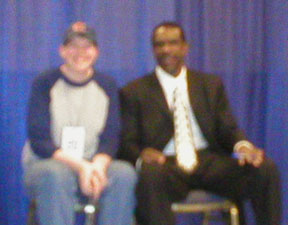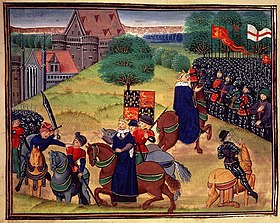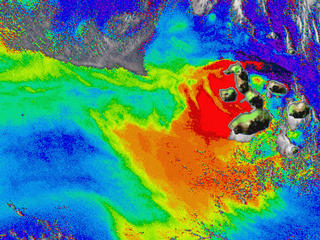Deadpan is a form of comedic delivery in which humour is presented without exhibiting a change in emotion or facial expression. Deadpan is a type of dry humour.
Etymology
Notable deadpan comedians
Dave Allen, a pessimistic Irish stand-up.
Michael Ian Black, David Wain, and Michael Showalter are the trio in the stand up act known as Stella.
Todd Barry, American stand-up comedian.
Garry Shandling, American stand-up and actor of the Larry Sanders Show.
Jimmy Carr, English stand-up comedian.
Stephen Colbert, American comedian, see the Comedy Central program, the Colbert Report
Jim Gaffigan, American comedian.
Jack Dee, British stand-up comedian.
Zach Galifianakis, American stand-up comedian.
Elliot Goblet, Australian comedian Jack Levi's standup persona
Mitch Hedberg, American stand-up comedian.
Jeremy Hotz, Canadian stand-up comedian.
Dave Hughes, Australian stand-up comedian.
Jonathan Katz, American comedian, actor and voice actor
Demetri Martin, American comedian, actor, and writer.
Sam Wiewel, American stand-up comedian and actor.
Paul Merton, British comedian and actor, of Have I Got News For You.
Paul Mooney, American comedian and writer
Dave Mordal, American comedian, contestant on Last Comic Standing.
Bob Newhart, American stand-up comedian, TV and film actor, and voice actor
Sarah Silverman, American stand-up comedienne.
Jackie Vernon caricatured the typically boring slide-projector presentation of vacation photos.
Steven Wright, American stand-up comedian.
Pierre Légaré, Quebecois stand-up comedian. Stand-up comedians
Buster Keaton, known as "Great Stone Face", became famous for never cracking a smile in any of his films. Strictly speaking, his was not a deadpan approach, since his face was actually very expressive. He subtly portrayed bemusement, anger, fear, and other emotions, but never smiled in a single one of his classic silents. In Go West, a cowboy forces him to smile, which he does by using his fingers to pull up the sides of his mouth. The result is a ghastly parody of a smile. Keaton also mugged, cried, laughed, and otherwise carried on in several of his earliest silent two-reelers with Fatty Arbuckle. His first smile in sound movie occurred in San Diego, I Love You (1944).
Stan Laurel, of the double act Laurel and Hardy.
Bill Murray. Most of his work entails him delivering overtly humorous lines with a genuine look of disinterest or indifference on his face, particularly in later works such as Lost in Translation, Broken Flowers and The Lost City.
Leslie Nielsen progressed from being a dramatic actor in films such as The Poseidon Adventure to a comedic actor due in large part to his seriousness in delivering nonsensical lines in movies such as Airplane! ("Surely you can't be serious!" "I am serious. And don't call me Shirley.") and The Naked Gun series.
Peter Sellers, most famously for his role as the United States President (as well as Dr. Strangelove, and Captain Mandrake) in Stanley Kubrick's Dr. Strangelove and his portrayal of bumbling French police inspector Jacques Clouseau.
Ben Stein, who was originally a university professor, found a new career as a comedy actor by exploiting the stereotype of the dull academic, often acting as a straight man.
Christopher Walken is best known for his deadpan effect and offkey pauses, which is most notable in films such as Pulp Fiction and True Romance.
Chevy Chase, known for his roles as Ty Webb in Caddyshack and Clark Griswold in National Lampoon's Vacation Film
Stephen Colbert in Comedy Central's The Colbert Report.
Jack Benny and Johnny Carson were famous for their "takes", blank stares toward the camera in response (or nonresponse) to something funny that had just happened.
Peter Cook, pioneering British comedian of stage, screen, and script.
Kenny Mayne, SportsCenter anchor.
The Office, NBC comedy which features Steve Carell, thrives on deadpan humor
Rick Mercer, in This Hour has 22 Minutes and Talking to Americans (by making outlandish claims about Canada).
Bob Newhart is known for his deadpan delivery and his slight stammer, as featured on The Bob Newhart Show and Newhart, and in classic standup routines.
Christopher Morris The alter ego of Chris Morris portrayed on Brass Eye, a satirical news investigation show in which the most hysterical headlines and storys are told completely seriously
Pat Paulsen spoke in a blank monotone with heavy eyelids, usually opening with, "Good evening, I'm really excited to be here."
Anne Robinson, British Weakest Link host known for acerbic comedic remarks.
Mo Rocca
Michael Ian Black
Jemaine Clement and Bret McKenzie of HBO's "Flight of the Conchords (series)" heavily incorporate straightfaced expressions in response to jokes into their comedic and musical routines on the show.
 Other
OtherUnintentional humor
Deadpan violence
 Prominent dockyards and shipyards
Prominent dockyards and shipyards
 Hall of Fame Candidacy
Hall of Fame Candidacy
 See also
See also Minor islands
Minor islands



 White-box, black-box, and gray-box testing
White-box, black-box, and gray-box testing